Lampriformes is an order of ray-finned fish. Members are collectively called lamprids or lampriforms, and unite such open-ocean and partially deep-sea Teleostei as the crestfishes, oarfish, opahs, and ribbonfishes. A synonym for this order is Allotriognathi, while an often-seen, but apparently incorrect, spelling variant is Lampridiformes. They contain seven extant families which are generally small but highly distinct, and a mere 12 lampriform genera with some 20 species altogether are recognized.

Carcharodon is a genus of sharks within the family Lamnidae, colloquially called the "white sharks." The only extant member is the great white shark. The extant species was preceded by a number of fossil (extinct) species including C. hubbelli and C. hastalis. The first appearance of the genus may have been as early as the Early Miocene or Late Oligocene.

Opahs, also commonly known as moonfish, sunfish, kingfish, and redfin ocean pan are large, colorful, deep-bodied pelagic lampriform fishes comprising the small family Lampridae.

A viperfish is any species of marine fish in the genus Chauliodus. Viperfishes are mostly found in the mesopelagic zone and are characterized by long, needle-like teeth and hinged lower jaws. A typical viperfish grows to lengths of 30 cm (12 in). Viperfishes undergo diel vertical migration and are found all around the world in tropical and temperate oceans. Viperfishes possess photophores along the ventral side of their body, likely used to camouflage them by blending in with the less than 1% of light that reaches to below 200 meters depth.

The Gempylidae are a family of perciform fishes commonly known as snake mackerels or escolars. The family includes about 25 species.
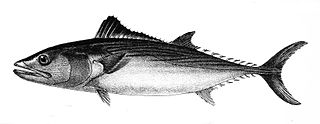
Sarda chiliensis, the eastern Pacific bonito, is a marine species of bonito. It ranges from Ecuador to Chile. Sarda lineolata, which ranges from Alaska to Mexico was formerly considered a subspecies, as Sarda chiliensis lineolata, but this treatment renders the species geographically disjunct.

A piscivore is a carnivorous animal that eats primarily fish. The name piscivore is derived from Latin piscis 'fish', and vorō 'to devour'. Piscivore is equivalent to the Greek-derived word ichthyophage, both of which mean "fish eater". Fish were the diet of early tetrapod evolution ; insectivory came next; then in time, the more terrestrially adapted reptiles and synapsids evolved herbivory.
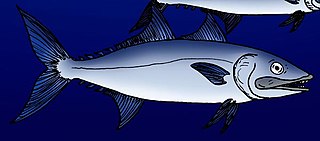
Zaphlegulus venturaensis is an extinct, superficially mackerel-like, fish related to the cutlassfish and snake mackerels found off the coast of what is now California during the late Miocene. Z. venturaensis was shorter, but stouter than either of the other two better known genera of the extinct family Zaphlegidae, Thyrsocles and Euzaphleges, which also lived at the same time.
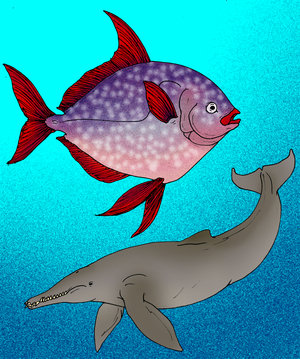
Megalampris keyesi is an extinct opah from the late Oligocene of New Zealand about 26 million years ago. It was recovered from the Otekaike Limestone in North Otago, by a team led by Ewan Fordyce from the Geology Department of the University of Otago. The species is named in honour of the New Zealand palaeontologist Ian Warwick Keyes (1938-2004). It is the largest fossil teleost fish from New Zealand, the spectacular remains comprise three large limestone blocks containing mostly caudal skeleton. These are on display in the Otago Museum, Dunedin, New Zealand. Some of the vertebral centra preserved are 90 mm across. Comparison with the skeletons of living Lampris species suggest the giant fish was around 4 metres (13 ft) in length when alive, which is twice the length of the largest living opah species, Lampris guttatus. The cleithra in the fossil are significantly enlarged to suggest that Megalampris used the pectoral swimming mode characteristic of moonfishes.
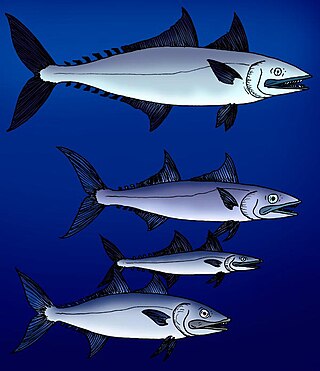
Euzaphlegidae is a family of extinct escolar-like fish closely related to the snake mackerels. Fossils of euzaphlegids are found from Paleocene to Late Miocene-aged marine strata of Europe, the Caucasus Mountains, India, Iran, Turkmenistan, Italy, and Southern California.

Euzaphleges longurio is an extinct, superficially mackerel-like fish related to the escolar and snake mackerels. Euzaphleges was found off the coast of what is now California during the late Miocene. It was smaller than the very similar Thyrsocles and longer and more slender than Zaphlegulus, which also lived at the same time. It was much longer than the poorly known Trossulus.
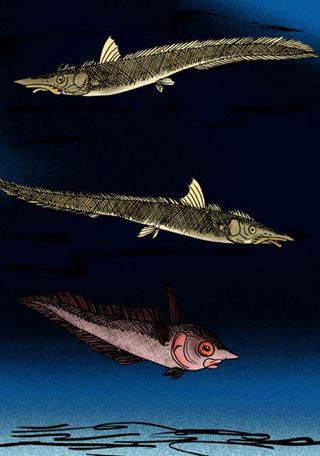
Laytonia is an extinct genus of prehistoric halosaur that lived in deep water off the North American Pacific Coast from the Zemorrian Epoch until during the Upper Miocene subepoch, when tectonic uplift effectively destroyed the genus' habitat by making the deep water too shallow.
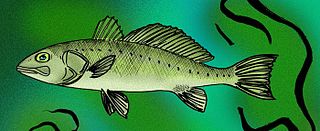
Lompoquia retropes is an extinct genus of ray-finned fishes belonging to the family Sciaenidae, the drums. These fishes lived what is now Southern California during the Upper Miocene subepoch.
Ioscion morgani is an extinct prehistoric bony fish that lived during the Upper Miocene subepoch of what is now Southern California. It is primarily known from incomplete fossils, such as the holotype, which consists of a broken backbone. Although the head is unknown, enough of the animal's anatomy suggests a relationship with the jackfishes of Carangidae.
Bregmacerinia is an extinct genus of prehistoric bony fish that lived during the early part of the Miocene epoch.
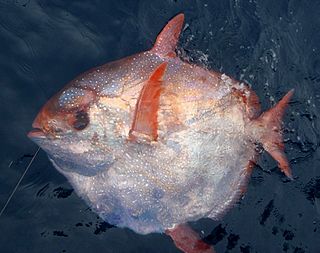
Lampris guttatus, commonly known as the opah, cravo, moonfish, kingfish, and Jerusalem haddock, is a large, colorful, deep-bodied pelagic lampriform fish belonging to the family Lampridae, which comprises the genus Lampris.
Araeosteus rothi is an extinct species of bony fish closely related to the modern-day prowfish, Zaprora silenus. A. rothi is found in Late Miocene marine strata of Southern California, primarily the Diatom Beds of Lompoc and the Santa Monica Mountains.
The Yaquina Formation is a geologic formation in Oregon. It preserves fossils dating back to the Paleogene period.
Lampris immaculatus, commonly known as the southern opah or southern moonfish, is a species of fish native to the Southern Ocean. The species is found commonly in New Zealand waters. They are caught commercially using long-line fishery in New Zealand. The most common prey species for the southern opah are juvenile onychoteuthid squid Moroteuthis ingens, which were found in 93% of 69 fish. It was discovered that 14% of the opahs contained plastic pollutants in their digestive tract, which indicates signs of high plastic pollution in the Southwest Atlantic.

Cosmopolitodus planus, also known as the hooked-tooth mako shark or hooked mako shark, is an extinct lamnid that lived during the Miocene epoch from 23 to 5 million years ago. C. planus can be found only in marine deposits on the Pacific Rim, especially the west coast of the United States. Teeth belonging to C. planus can reach lengths of 2.0 in (5.0 cm), and are often found in the Temblor Formation of Bakersfield, California.














